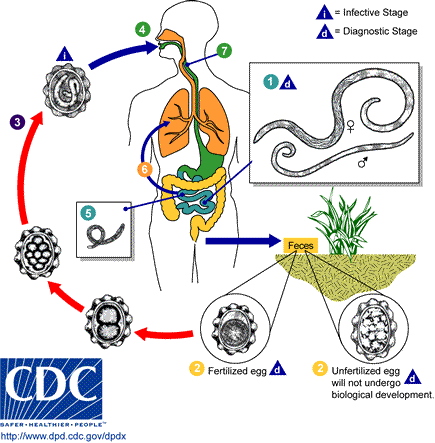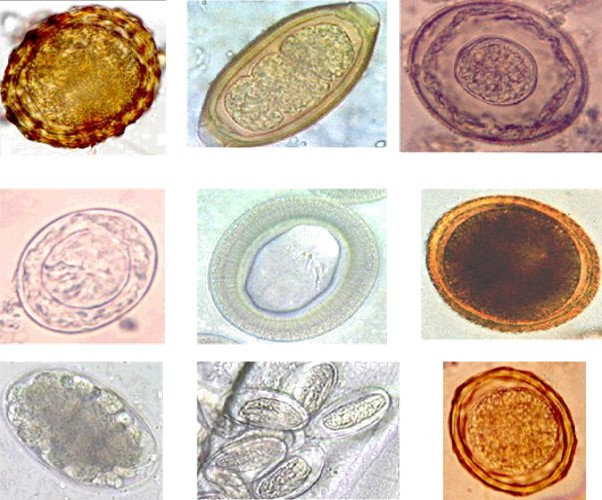|
Ascaris
''Ascaris'' is a nematode genus of parasitic worms known as the "small intestinal roundworms". One species, ''Ascaris lumbricoides'', affects humans and causes the disease ascariasis. Another species, ''Ascaris suum'', typically infects pigs. Other ascarid genera infect other animals, such as '' Parascaris equorum'', the equine roundworm, and '' Toxocara'' and '' Toxascaris'', which infect dogs and cats. Their eggs are deposited in feces and soil. Plants with the eggs on them infect any organism that consumes them. ''A. lumbricoides'' is the largest intestinal roundworm and is the most common helminth infection of humans worldwide. Infestation can cause morbidity by compromising nutritional status, affecting cognitive processes, inducing tissue reactions such as granuloma to larval stages, and by causing intestinal obstruction, which can be fatal. Morphology and Anatomy * Adult: cylindrical shape, creamy white or pinkish in color * Male: average ; more slender than the fe ... [...More Info...] [...Related Items...] OR: [Wikipedia] [Google] [Baidu] |
Ascaris Lumbricoides
''Ascaris lumbricoides'' is a large parasitic worm, parasitic Nematoda, roundworm of the genus ''Ascaris.'' It is the most common parasitic worm in humans. An estimated 807 million–1.2 billion people are infected with ''Ascaris lumbricoides'' worldwide. People living in tropics, tropical and subtropics, subtropical countries are at greater risk of infection. Infection by ''Ascaris lumbricoides'' is known as ascariasis. It has been proposed that ''Ascaris lumbricoides'' and ''Ascaris suum'' (pig roundworm) are the same species. Life cycle ''Ascaris lumbricoides'', a roundworm, infects humans via the fecal-oral route. Eggs released by adult females are shed in feces. Unfertilized eggs are often observed in fecal samples but never become infective. Fertilized eggs embryonate and become infectious after 18 days to several weeks in soil, depending on the environmental conditions (optimum: moist, warm, shaded soil).Parasites - Ascariasis. (14 February 2018). Retrieved from https:/ ... [...More Info...] [...Related Items...] OR: [Wikipedia] [Google] [Baidu] |
Ascariasis
Ascariasis is a disease caused by the parasitic roundworm ''Ascaris lumbricoides''. Infections have no symptoms in more than 85% of cases, especially if the number of worms is small. Symptoms increase with the number of worms present and may include shortness of breath and fever at the beginning of the disease. These may be followed by symptoms of abdominal swelling, abdominal pain, and diarrhea. Children are most commonly affected, and in this age group the infection may also cause poor weight gain, malnutrition, and learning problems. Infection occurs by ingesting food or drink contaminated with ''Ascaris'' eggs from feces. The eggs hatch in the intestines, the larvae burrow through the gut wall, and migrate to the lungs via the blood. There they break into the Pulmonary alveolus, alveoli and pass up the Vertebrate trachea, trachea, where they are coughed up and may be swallowed. The larvae then pass through the stomach a second time into the intestine, where they become adul ... [...More Info...] [...Related Items...] OR: [Wikipedia] [Google] [Baidu] |
Ascaris Esophagus (cropped)
''Ascaris'' is a nematode genus of parasitic worms known as the "small intestinal roundworms". One species, ''Ascaris lumbricoides'', affects humans and causes the disease ascariasis. Another species, ''Ascaris suum'', typically infects pigs. Other ascarid genera infect other animals, such as ''Parascaris equorum'', the equine roundworm, and '' Toxocara'' and '' Toxascaris'', which infect dogs and cats. Their eggs are deposited in feces and soil. Plants with the eggs on them infect any organism that consumes them. ''A. lumbricoides'' is the largest intestinal roundworm and is the most common helminth infection of humans worldwide. Infestation can cause morbidity by compromising nutritional status, affecting cognitive processes, inducing tissue reactions such as granuloma to larval stages, and by causing intestinal obstruction, which can be fatal. Morphology and Anatomy * Adult: cylindrical shape, creamy white or pinkish in color * Male: average ; more slender than the female ... [...More Info...] [...Related Items...] OR: [Wikipedia] [Google] [Baidu] |
Ascaris Suum
''Ascaris suum'', also known as the large roundworm of pig, is a parasitic nematode that causes ascariasis in pigs. While roundworms in pigs and humans are today considered as two species (''A. suum'' and '' A. lumbricoides'') with different hosts, cross-infection between humans and pigs is possible; some researchers have thus argued they are the same species. Ascariasis is associated with contact to pigs and pig manure in Denmark. ''A. suum'' is distributed worldwide and grows up to in length. ''Ascaris'' infections are treated with ascaricides. ''A. suum'' is in the family Ascarididae, and is one of the oldest associations to mankind. Life cycle Pigs get infected with ''A. suum'' by ingesting infectious parasite eggs that are present in the environment. The larvae of Ascaris complete two moults within the egg; therefore, the larvae emerging from the egg is not a second-stage larva (L2) as was previously presumed, but rather a third stage larva (L3) covered by a loosened ... [...More Info...] [...Related Items...] OR: [Wikipedia] [Google] [Baidu] |
Parasitic Worms
Parasitic worms, also known as helminths, are a polyphyletic group of large macroparasites; adults can generally be seen with the naked eye. Many are intestinal worms that are soil-transmitted and infect the gastrointestinal tract. Other parasitic worms such as schistosomes reside in blood vessels. Some parasitic worms, including leeches and monogeneans, are ectoparasites thus, they are not classified as helminths, which are endoparasites. Parasitic worms live in and feed in living hosts. They receive nourishment and protection while disrupting their hosts' ability to absorb nutrients. This can cause weakness and disease in the host, and poses a global health and economic problem. Parasitic worms cannot reproduce entirely within their host's body; they have a life cycle that includes some stages that need to take place outside of the host. Helminths are able to survive in their mammalian hosts for many years due to their ability to manipulate the host's immune response ... [...More Info...] [...Related Items...] OR: [Wikipedia] [Google] [Baidu] |
Nematode
The nematodes ( or ; ; ), roundworms or eelworms constitute the phylum Nematoda. Species in the phylum inhabit a broad range of environments. Most species are free-living, feeding on microorganisms, but many are parasitic. Parasitic worms (helminths) are the cause of soil-transmitted helminthiases. They are classified along with arthropods, tardigrades and other moulting animals in the clade Ecdysozoa. Unlike the flatworms, nematodes have a tubular digestive system, with openings at both ends. Like tardigrades, they have a reduced number of Hox genes, but their sister phylum Nematomorpha has kept the ancestral protostome Hox genotype, which shows that the reduction has occurred within the nematode phylum. Nematode species can be difficult to distinguish from one another. Consequently, estimates of the number of nematode species are uncertain. A 2013 survey of animal biodiversity suggested there are over 25,000. Estimates of the total number of extant species are su ... [...More Info...] [...Related Items...] OR: [Wikipedia] [Google] [Baidu] |
Parascaris Equorum
''Parascaris equorum'' is a species of ascarid that is the equine roundworm. Amongst horse owners, the parasites are colloquially called "Ascarids". This is a host-specific helminth intestinal parasite that can infect horses, donkeys, and zebras. Horses up to six months of age are the most susceptible to infection. After this time, infection rates begin to decline and is extremely uncommon in horses over twelve months of age. It cannot infect humans or other animals. It is yellow-white in color, and females can become as large as in length. Found worldwide, ''P. equorum'' is one of the most difficult equine parasites to kill, requiring larger doses of more powerful anthelmintic medications than are needed for other equine parasites. Life cycle ''P. equorum'' is sexually dimorphic, the females are significantly larger than males. While males only grow up to 15–28 cm in length, the females can grow up to 50 cm in length. They are a white-colored, cylindrical worm ... [...More Info...] [...Related Items...] OR: [Wikipedia] [Google] [Baidu] |
Pepsin
Pepsin is an endopeptidase that breaks down proteins into smaller peptides and amino acids. It is one of the main digestive enzymes in the digestive systems of humans and many other animals, where it helps digest the proteins in food. Pepsin is an aspartic protease, using a catalytic aspartate in its active site. It is one of three principal endopeptidases (enzymes cutting proteins in the middle) in the human digestive system, the other two being chymotrypsin and trypsin. There are also exopeptidases which remove individual amino acids at both ends of proteins (carboxypeptidases produced by the pancreas and aminopeptidases secreted by the small intestine). During the process of digestion, these enzymes, each of which is specialized in severing links between particular types of amino acids, collaborate to break down dietary proteins into their components, i.e., peptides and amino acids, which can be readily absorbed by the small intestine. The cleavage specificity o ... [...More Info...] [...Related Items...] OR: [Wikipedia] [Google] [Baidu] |
10th Edition Of Systema Naturae
The 10th edition of ''Systema Naturae'' (Latin; the English title is ''A General System of Nature'') is a book written by Swedish naturalist Carl Linnaeus and published in two volumes in 1758 and 1759, which marks the starting point of zoological nomenclature. In it, Linnaeus introduced binomial nomenclature for animals, something he had already done for plants in his 1753 publication of ''Species Plantarum''. Starting point Before 1758, most biological catalogues had used polynomial names for the taxa included, including earlier editions of ''Systema Naturae''. The first work to consistently apply binomial nomenclature across the animal kingdom was the 10th edition of ''Systema Naturae''. The International Commission on Zoological Nomenclature therefore chose 1 January 1758 as the "starting point" for zoological nomenclature and asserted that the 10th edition of ''Systema Naturae'' was to be treated as if published on that date. Names published before that date are unavailable, ... [...More Info...] [...Related Items...] OR: [Wikipedia] [Google] [Baidu] |
Pigs
The pig (''Sus domesticus''), also called swine (: swine) or hog, is an omnivorous, domesticated, even-toed, hoofed mammal. It is named the domestic pig when distinguishing it from other members of the genus '' Sus''. Some authorities consider it a subspecies of ''Sus scrofa'' (the wild boar or Eurasian boar); other authorities consider it a distinct species. Pigs were domesticated in the Neolithic, both in China and in the Near East (around the Tigris Basin). When domesticated pigs arrived in Europe, they extensively interbred with wild boar but retained their domesticated features. Pigs are farmed primarily for meat, called pork. The animal's skin or hide is used for leather. China is the world's largest pork producer, followed by the European Union and then the United States. Around 1.5 billion pigs are raised each year, producing some 120 million tonnes of meat, often cured as bacon. Some are kept as pets. Pigs have featured in human culture since Neolithic time ... [...More Info...] [...Related Items...] OR: [Wikipedia] [Google] [Baidu] |







